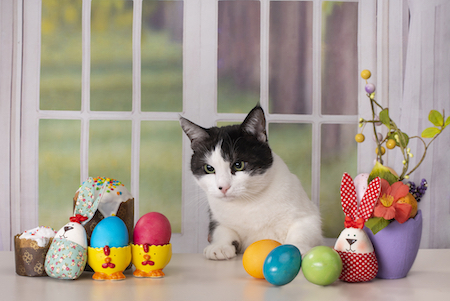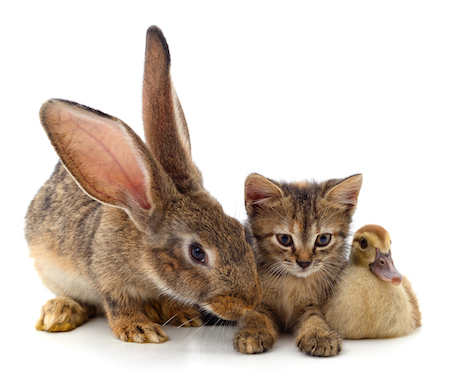Easter and Spring Safety Tips for Pets: Hop into Spring Safely
Posted: 11/06/2023 | BY: Erin Cain | Categories: Uncategorized
Easter is a holiday when many people celebrate the arrival of spring. For pet owners, it’s also a time to be extra vigilant about the safety of their furry friends. Easter is often filled with family gatherings and festivities, all of which can be exciting for our four-legged companions and potentially dangerous. Let’s discuss some Easter safety tips for keeping our pets healthy during the spring season.

Beware of Easter baskets with candy goodies.
Even though people love the sweet treats found in an Easter basket, most candy is dangerous to dogs and cats. Chocolate has always been a well-known hazard for pets; however. That hazard can be doubled if the chocolate or candy in the basket contains xylitol, a naturally occurring sugar alcohol. Combine xylitol with chocolate, and you have a one-two toxic punch to dogs’ and cats’ health. That’s why it’s best practice to keep Easter treats far from our furry friends.
Xylitol is found in many foods and drinks, usually labeled “sugar-free.” It can cause hypoglycemia or low blood glucose levels, which is dangerous for your pet and may require hospitalization. In worst-case scenarios, xylitol poisoning can lead to a pet’s death. Keep candy out of paws’ reach to keep your dog or cat safe this Easter.
Most Easter baskets include decorative plastic Easter grass, which is also dangerous for your pet if ingested. Shiny and chewy objects often find their way into our pets’ mouths. This scenario can happen quickly, especially when pet parents and their family are distracted and the pet is bored. Ensure that children’s small plastic Easter eggs are not accessible by your furry friend. They are a potential choking hazard and can cause a gastrointestinal obstruction that requires costly emergency surgery.

Watch out for toxic spring plants.
Springtime is an excellent time for planting and enjoying early blooms, but some plants can be hazardous to your pet’s health. The most common flower found in decorations and religious services is the Easter lily at Easter. Unfortunately, Easter lilies are extremely toxic, especially for cats. It doesn’t take much exposure to Easter lilies for our feline friends to be in severe medical distress. Plant toxicity in cats quickly causes liver and kidney failure and may require emergency surgery or long-term health treatments.
Kidney failure and death can occur from a tiny lick of pollen or nibble on a leaf. Symptoms will develop within six to twelve hours after exposure. If your kitty has access to a lily plant and suddenly shows signs of illness, take her to the veterinarian immediately. The same warning goes for other lilies, including tiger lilies, daylilies, stargazers, wood and Western, Asiatic, Japanese Snow, and red lilies.
Other plants, such as hyacinths, tulips, and irises, are toxic to cats and dogs. Ingestion of these plants typically causes vomiting, excessive drooling, and diarrhea. A pet parent’s best bet is to keep house plants away from their pup and cat just to be safe.
Avoid spring cleaning dangers.
When the weather gets warmer, many pet owners take a deep breath of fresh air and start tackling our spring cleaning checklist. But some of the cleaning supplies we use to clean up our homes may not be safe for our furry family members. You may think your pets are safe from harm when you use products labeled “natural,” but this isn’t always true. It’s a good rule of thumb to always read labels carefully when shopping for products tagged “natural,” as there may still be harmful chemicals.
Keep your pet safe and sound during spring cleaning by ensuring that the products you use are pet-friendly. Even better, secure your cat or pup in a different area from the one you are cleaning, and don’t give them access to the room until all cleaning products are dried. If you’re going to use a potentially toxic cleaning product, make sure that your pet cannot access the area and is away from exposure to poisonous substances.

Don’t feed your pets table scraps.
Easter, like other holidays, involves a holiday feast full of rich meats, vegetables, and desserts. However, none of these foods should be fed to your dog or cat. Some cats and most dogs will try to convince their pet parents and guests otherwise, but giving your pet leftovers from the dinner table is a potentially deadly move. Although it is tempting to share table scraps with that cute pup begging under the table, avoid feeding your kitty or pup anything other than their own food.
Consuming fatty foods, including ham, lamb, pork roast, and meat bones, can make your pet sick. These foods are too rich for your pet’s stomach to digest, resulting in an upset stomach, abdominal pain, or pancreatitis. Other dangerous foods to keep away from your pet are baked goods, alcohol, caffeinated drinks, grapes and raisins, onions, and garlic. Be on the lookout for open garbage cans, unattended plates, or serving dishes left within your pet’s reach.
Keep dogs from begging for food while guests are around is by feeding them beforehand. Let guests know that table scraps are off-limits for furry friends. Instead, have an appropriate amount of pet treats available to give your pets in place of dangerous foods.

Be on the lookout for seasonal allergies.
As with humans, many pets are prone to spring seasonal allergies. If you notice your pet is scratching more often than usual, and their skin is red, irritated, and swollen, or their skin is raw with hair loss, they may have an allergy.
The only way to know if your pet has an allergy is by getting them tested. Itchy dogs and cats whose skin irritation goes beyond superficial scratching are likely allergic to something environmental. A veterinarian can prescribe topical and oral medications to manage the allergic reactions in your pet. Without treatment, the scratching and irritation will continue, and your pet may scratch themselves so much that they develop infections.
Prevent exposure to fleas and ticks.
As we welcome the warmer weather and more time outside, it’s important to remember to keep our pets safe from parasites. Fleas and ticks are more present in and around our homes than we think. It takes a walk near or in tall grass, some running around in the backyard, a hike on a nearby trail, or a trip to the dog park, and your pup could bring home some unwanted guests. Once these bugs are in your home, the rest of your pets are in danger of being unwilling hosts to these parasites.
Keep your pup or kitty flea-free this spring by making sure they’re on the proper preventative treatment recommended by their vet. If possible, avoid walking near tall grass and do routine skin and fur checks for your dog before bringing him back into the house after an outside romp.

Don’t bring home real bunnies and chicks.
Yes, bunnies and chicks are adorable and perfect for the Easter holiday. Still, your other pets, especially dogs and cats, may look at the new additions as living prey. Sadly, it’s not unheard of for tiny chicks and bunnies to suffer and eventually die at the paws of the family cat or dog with a strong prey drive. In the best interest of all involved, you avoid bringing these small animals into your home without careful and slow introductions to your other pets. Some pets cannot overcome their prey drive, meaning the chicks and rabbits will always be in danger.
Instead of real animals, give your pup a squeaky rabbit toy and your kitty a chick toy stuffed with catnip. They will love the Easter gifts, and no pet will get hurt.

Have a pet safety net with a pet insurance plan.
Accidents happen with our pets, and the smartest move a pup or kitty parent can make to anticipate future emergencies is to purchase an insurance plan. With discounts available for more than one furry companion, it’s the perfect time to make sure your pup and kitty are covered should they need emergency treatment. Pet health insurance also saves you the stress of wondering how you can afford your pet’s care. Most providers offer plans that reimburse up to 90% of those costly vet bills.
Pet Insurance Review is all about medical care for pets without the financial strain on dog and cat parents. Fill out a free quote, and we will find the best insurance provider options for your pet and budget. Get a hop on it, and protect your cat or dog today!
References:
- Jones, N. (n.d.). Chocolate Toxicity in Dogs: Signs and What To Do. Retreived from https://veterinaryemergencygroup.com/blog/chocolate-toxicity-in-dogs/
- Schmid, R., Brutlag, A. (2022). Xylitol Poisoning in Dogs. Retrieved from https://vcahospitals.com/know-your-pet/xylitol-toxicity-in-dogs
- U.S. Food & Drug Administration. (2021). Lovely Lilies and Curious Cats: A Dangerous Combination. Retrieved from https://www.fda.gov/animal-veterinary/animal-health-literacy/lovely-lilies-and-curious-cats-dangerous-combination
- Pet Poison Helpline. (2022). Top Poisonous Plants to Pets. Retrieved from https://www.petpoisonhelpline.com/pet-owners/basics/top-10-plants-poisonous-to-pets/
- Natale, M. (2022). The Best Pet-Friendly Cleaning Supplies That are NonToxic to Animals. Retrieved from https://www.bestproducts.com/lifestyle/pets/g3443/pet-safe-non-toxic-cleaning-supplies/
- Calderone, J. (2018). 8 Toxic Foods for Dogs. Retrieved from https://www.consumerreports.org/pets/toxic-foods-for-dogs/
- North, C. (2020). Pancreatitis in Dogs and Cats. Retrieved from https://www.vetspecialists.com/vet-blog-landing/animal-health-articles/2020/04/09/pancreatitis-in-dogs-and-cats
- Animal Humane Society. (2022). Signs your pet has seasonal allergies — and what you can do to help. Retrieved from https://www.animalhumanesociety.org/news/signs-your-pet-has-seasonal-allergies-and-what-you-can-do-help
- AKC Staff. (2022). 11 Flea & Tick Prevention Tips. Retrieved from https://www.akc.org/expert-advice/health/flea-and-tick-prevention-tips/
- Pilet, J. (2021). Leave the live bunnies, chicks, and ducklings out of the basket. Retrieved from https://www.foodsafetynews.com/2021/04/leave-the-live-bunnies-chicks-and-ducklings-out-of-the-basket/
Disclaimer
The information contained on this blog is intended for informational and educational purposes only and should not be construed as medical advice. It is not a substitute for professional veterinary care. Always consult with your veterinarian before making any changes to your pet's health care or treatment plan.
The authors of this blog are not veterinarians and do not claim to be experts in pet health. The information provided here is based on our own experiences and research, as well as information from reputable sources. However, we cannot guarantee the accuracy or completeness of this information.
We encourage you to do your own research and consult with your veterinarian before making any decisions about your pet's health.
Previous post
Why Do Dogs Lick Everything?Next post
Tips for Backpacking with DogsCompare top pet insurance providers plans.
Enter your dog’s age in years and months to calculate their age equivalent to human years.
Calculate your dog’s ageEnter your cat’s age in years and months to calculate their age equivalent to human years.
Calculate your cat’s age